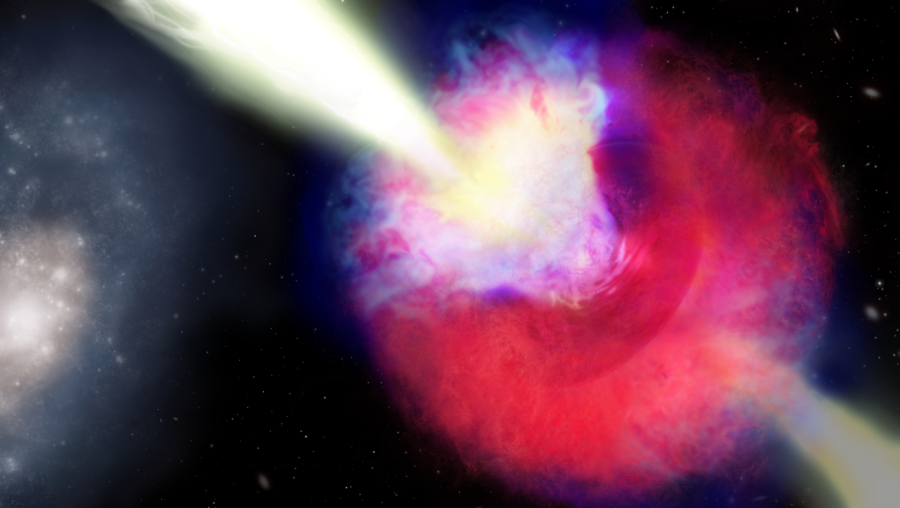NU researchers study neutron star merger that defies former assumptions of kilonova explosions
Photo courtesy of Aaron M. Geller/Northwestern/CIERA and IT Research Computing Services
A team led by NU researchers found a neutron star merger that resulted in a surprising gamma-ray burst of 50 seconds.
February 17, 2023
About 1.1 billion light years away, two neutron stars merged. The collision stripped material off the neutron stars, resulting in a kilonova explosion and a gamma-ray burst.
But when the GRB was identified on Earth in 2021, a team led by Northwestern researchers noticed something unusual.
The GRB lasted about 50 seconds, a time period typically associated with the deaths of massive stars. But, several characteristics of the burst, including the spike pattern of gamma rays, appeared to be consistent with results of a neutron star merger.
“Every other gamma-ray burst we’d seen that came from neutron star mergers was two seconds or less,” Jillian Rastinejad, lead author and fourth-year astronomy Ph.D. student, said. “And so this GRB paradigm of these two different classes, two different progenitors, was kind of broken for the first time.”
Rastinejad and other researchers at the Center for Interdisciplinary Exploration and Research in Astrophysics published a paper in December detailing the neutron star merger and its corresponding GRB.
Astronomers now know neutron star mergers can be associated with long GRBs as well as short ones, Rastinejad said.
The CIERA team began studying the GRB in December 2021. After initial observations of the burst, Rastinejad said researchers used the Very Large Array in New Mexico and telescopes at the MMT Observatory in Arizona and Gemini Observatory in Hawaii to continue their observations.
Specialists on different wavelengths of light, such as gamma rays and radio waves, studied the kilonova’s afterglow.
Although fifth-year astronomy Ph.D. student Genevieve Schroeder, didn’t detect any radio waves associated with the neutron star merger, she said her findings helped the rest of the team understand which other wavelengths were more likely to comprise the afterglow.
“Detections are always more exciting,” Schroeder said. “But it was exciting that a non-detection still was so useful because it did help constrain the rest of the model.”
CIERA’s findings disrupt what scientists had previously assumed about kilonovae, fifth-year astronomy Ph.D. student Anya Nugent said. Beyond the assumption that GRBs resulting from neutron star mergers are two seconds or shorter, Nugent also found this kilonova explosion originated in a fairly young galaxy.
That stood out, she said, because the only other kilonova she knows of in the local universe took place in an older galaxy where star formation was no longer taking place.
“It changes our perception of the environments that we’re able to find these events in, which I think is really interesting,” Nugent said.
Going forward, the researchers said they hope their work will guide astronomers in identifying more neutron star mergers.
The mergers are particularly significant because they create heavy elements like gold and platinum, Rastinejad said. An average kilonova produces about 200 times the mass of the Earth in gold, she said.
“(The research) could change the amount … of these heavy elements created,” Rastinejad said. “Then that all could play into, what are the sources of heavy elements?”
Schroeder said CIERA researchers are currently studying whether the neutron star merger they observed formed a magnetar — a giant neutron star. She and Rastinejad also said they hope to use gravitational wave detection technology like the Laser Interferometer Gravitational-Wave Observatory to look at the masses of neutron stars involved in mergers.
Studying astronomical events billions of light years away and making new discoveries never ceases to be exciting, Rastinejad said.
“As a young scientist, you come into the field and you’re told, ‘Okay, there are these two classes of GRBs and that’s what they are,’” she said. “And it’s very cool to say, ‘No, there’s still more science we need to figure out. There’s still things we don’t fully understand.’”
Email: avivabechky2025@u.northwestern.edu
Twitter: @avivabechky
Related Stories:
— NU astrophysicists observe brightest gamma-ray burst ever detected
— Dearborn Observatory and CIERA host public viewing of total lunar eclipse



